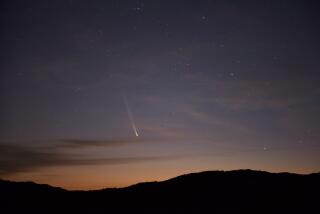A last look at Venus
On Tuesday afternoon, as earthbound routines continue — office workers breaking for coffee, people walking their dogs — something extraordinary will take place overhead. The planet Venus will begin to cross the face of the sun, appearing as a small, dark dot against it. (Don’t look without proper protection.) This transit of Venus will be visible here from 3:06 p.m. to 8:02 p.m. Transits occur in pairs separated by eight years, and don’t reoccur for another century. The previous one was June 8, 2004, but it wasn’t visible in Los Angeles. The next one is 105 years from now. So for virtually everyone reading this, here’s your first and last chance to see it.
There have been other rare astronomical phenomena this year. A solar eclipse brought out crowds to Griffith Observatory late last month. (The next time Los Angeles will get such a dramatic eclipse will be in 2071.) And from late February into late March, the planets Venus and Jupiter — the two brightest objects in the night sky after the moon — converged visually in the western sky, appearing closer and brighter than they will for years to come, easily observed from hillsides and street curbs.
Not so uncommon but still compelling was the appearance of the moon making its closest approach to Earth this year on a clear Saturday night in early May. (It will make a similarly close “super-moon” appearance next June.)
Whether such celestial events return next year or the next century, they are reminders to gaze up occasionally while we can still see the natural glow of the heavens. Urban density has caused a proliferation of street, building, billboard and car lights that pollute the night skies, blotting out the stars and planets. Sometimes it’s the visibility that’s harder to come by than the phenomenon. How remarkable to be someplace dark enough to glimpse the fuzzy band of starlight from the spiral arms of our Milky Way galaxy. Yet it’s there all the time. The transit of Venus, however, will be viewable — safely through filters like those on the telescopes available for free viewing at the Griffith Observatory— in late daylight.
In an age when the artificial luminescence of our iPhones, iPads, Androids and other digital devices commands so much of our attention, it’s worth putting them aside for an hour or even a few minutes to savor the wonders of the eternal sky.
More to Read
A cure for the common opinion
Get thought-provoking perspectives with our weekly newsletter.
You may occasionally receive promotional content from the Los Angeles Times.










